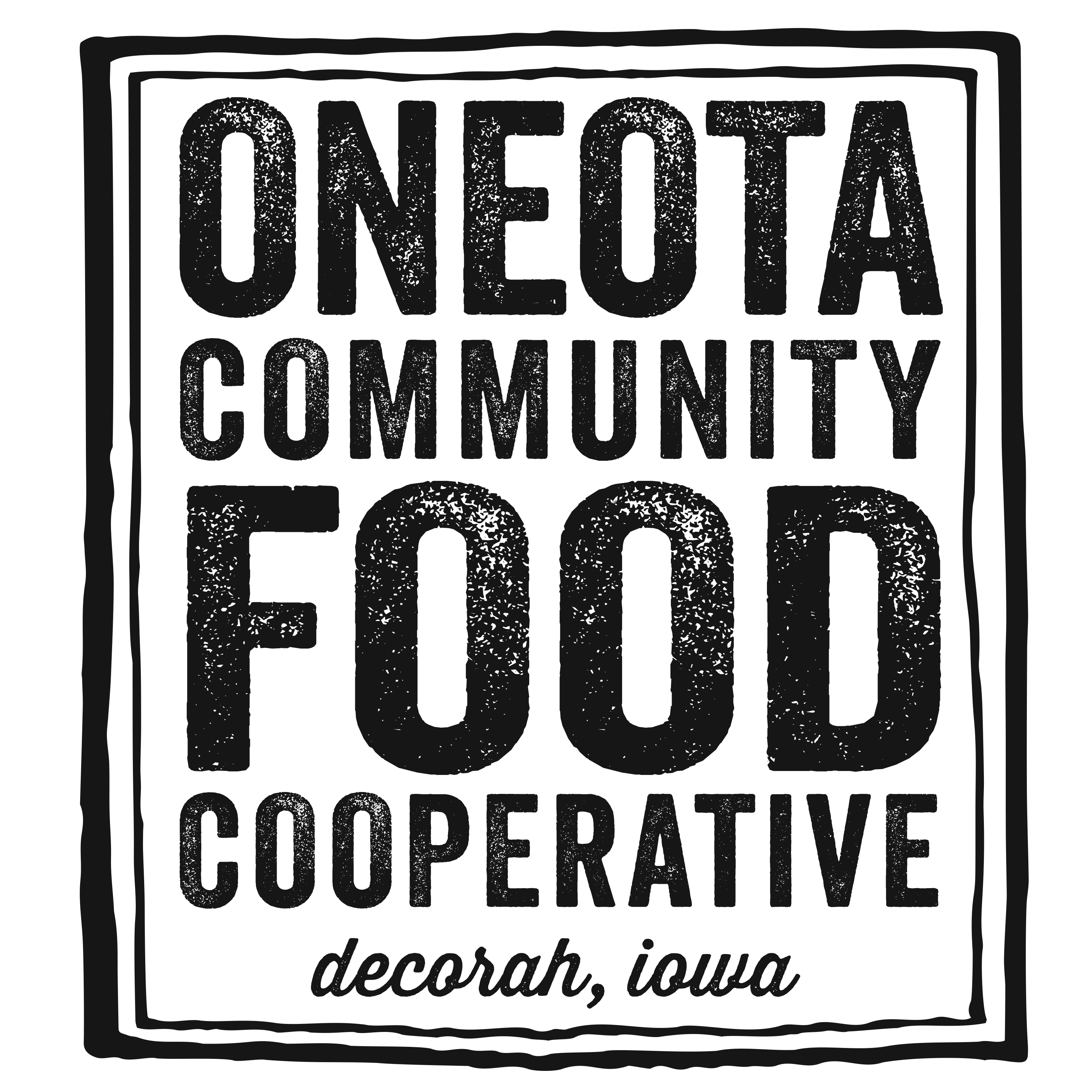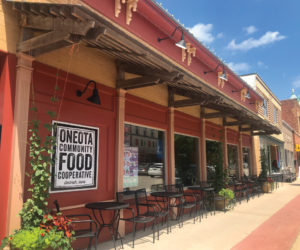
By: Katherine Hannigan, Assistant Produce Manager
When we’re young, we believe in fictions like Santa and the Tooth Fairy because 1) adults tell us they’re true and 2) we have evidence of them. There is verifiable proof. Grownups say, “Tonight, Santa will travel the world in his sleigh. He will bring presents to you and leave them there,” and they point to a place under a tree where there is only emptiness. It sounds impossible, but the next morning that space is stacked with brightly-wrapped boxes. Tags with our names and signed “Santa” are taped to them. Inside are the toys we pleaded for, but our parents said things like, “The day we let you kids get drums is the day we move to Costa Rica. Without kids,” about. Something extraordinary has happened, and it could not have been accomplished by the people we know. We begin to believe in magical creatures who are untethered by the laws that govern ordinary humans. We believe because, when we’re kids, life is full of so many things we don’t understand, anything seems possible. And we believe because of the evidence we find.
I found evidence of Barb Kraus before I met her. She left presents, in the Produce department.
I started working at the Co-op in winter, when the greens we sell come from far away. They’re packaged in sturdy plastic clams, with brand names in bold letters. I left the store one night, and when I came back the next afternoon new bags of greens were nestled in among the clams, as if they’d snuck in while everybody slept. Inside were lettuces mixed with tiny yellow and purple blooms. They were bright and crisp with the freshness of having just been picked, and traveling only a few miles to get to us. Small white labels, with a black-and-white print of geese and guineas, were affixed to the bags. “Canoe Creek Produce,” they read, “Certified Organic.” Hand-written beside that was “Salad Greens with Edible Flowers.” The packages were precious, like a gift one friend might leave on another’s porch. They were the prettiest greens I’d ever seen, and I thought, What sort of magic makes a salad that is also a bouquet in every bite? I asked Betsy, the Produce Manager, “Who is this Canoe Creek?” and she answered, “That’s Barb Kraus.”
Canoe Creek packages started showing up in our work area, too. I’d go to the front of the store to fill fruit and, when I returned, boxes I’d never seen before were in the walk-in cooler. They were white with ribbons of yellow duct tape around their middles. Their labels were hand-written. When I opened them, I found cilantro, parsley, arugula—so recently pulled from the ground and fragrant they filled the room with their perfume. “Oh,” I’d exclaim when I’d spot them, pleased and a little unnerved. Because no human had passed me with those boxes. They’d appeared as if tele-transported, or the deliverer moved with the stealth of a secret agent.
Then, one night, I met her. I turned, and standing in the doorway to the department was a small, trim woman, with curly hair and rosy cheeks. She was holding white boxes with yellow tape around their middles. “Barb Kraus!” I exclaimed. I knew it was her, because she was holding the evidence. She smiled and I took the boxes. We chatted a little, but not much. Delivery done, she disappeared, and I was not offended. Santa doesn’t have a lot of time to talk, either.
With time, I learned more about Barb. She’d been a veterinarian, then decided to grow food instead, I was told. I saw her at the Farmers’ Market, talking with folks, her tables loaded with good food and bunches of flowers—a little patch of paradise on the asphalt. I talked to her husband one night, after I gave him a taste of kiwi berries. “We’re growing these,” he told me. “Every January we sit and look through seed catalogues and say, ‘That would be fun to try.’ That’s how we decide what we’re going to grow.” I imagined the two of them sitting by a fire, smiling at each other and saying things like, “Shall we try to bring figs to northeast Iowa?” I imagined Barb planting in the Spring as the sun shone upon her and the birds sang tunes for her to hoe by. She never sweated, and the sky was filled with an infinite chain of rainbows…
I was making up a story about Barb Kraus in my head. It was magical.
Stories are wonderful things. We human beings like them. We use them to try to make sense of life and the world. But sometimes we get carried away. We romanticize real people and professions because we want to feel the way we did when we were kids, and we believed there was some magic that could turn everything into “happily ever after.”
But Barb Kraus is not a fiction. And life, my friends, is not a Disney movie. The rodents who’ve visited my house have not helped me with my chores. And the folks I know who were sure they were marrying princes? Let’s just say the lucky ones learned to live with their partners’ warts.
I have lived in the world long enough to know that life is wondrous and magical AND hard and finite. I’ve also found that the most valuable and inspiring stories are the true ones.
I wanted to learn Barb Kraus’s true story, not the one I was making up about her. I wanted to de-Disney-fy her: a little less Snow White, a little more substance. So I asked her if I could visit her farm and talk to her, and she said, “Okay.”
Canoe Creek sits about 7 miles northeast of Decorah. I drove to the farm a few days after Christmas. The hills were covered with white, and it was cold enough that my car engine was complaining.
There’s a long driveway, past fields and greenhouses and sheds, to get to the house. Two big dogs met me outside, barking to Barb, “You’ve got company!” When she opened the door, we all trotted into the kitchen together. There’s a huge wood table in the center of the room; around it, hand-painted tree stumps served as seats. Red birds that stay cheerful year-round were stenciled on the walls, and outside the window were flocks of all sorts, chirping and chattering at the feeders the family had put in the tree branches. Mischievous mice were painted on a breadbox, and rabbits rendered on paper and wood watched us while we talked. The wood stove in the corner was toasting everything to coziness and I thought, If seven small men pass by singing “Heigh Ho”, I might have to swallow that life-is-not-a-Disney-movie statement.
They didn’t.
We sat at the table, which is also Barb’s desk, and I started asking questions. But Barb isn’t chatty, and she’d probably rather talk about anything besides herself. Truly hearing her is like watching the sky and listening to the wind to figure out the weather—the tone of her voice and the movements of her face tell as much as her words.
I started by asking her why she calls her work “gardening”. “I don’t grow row crops. I don’t use machines. I do most of it by hand,” she explained, seriously, “so I don’t call it farming.” Then her face relaxed. “I want to touch the earth, the plants, and the animals. I want to feel them and know that connection.”
“You were a veterinarian before this,” I said. “Were there signs when you were young that this is what you might do?” She smiled as she remembered. “I was always different like that. Even when I was young, working in the garden wasn’t a chore like it was for other kids. It was a pleasure.” She gardened with her mother. Her eyes softened recalling the happiness of those times. “And when I was trying to decide what I would study in college, my mother said to me, ‘Just do what you love.’ I loved plants and I loved animals. First, I chose plants.”
She studied Horticulture for a year at ISU. And hated it. “They focused on the business of it; I wanted the science,” she told me, her voice low and slow with the sadness of that disappointment. “So then, I studied animals.”
She earned her veterinary degree. She worked in New York, then moved back to Decorah with her husband. They had children, they lived in the house and with the land she’d grown up on. They shared it with some animals, too. She worked and raised kids and grew things and drove to Decorah. A lot. “We were always driving into town,” she said. “We were always leaving this place.” I could hear in her voice the yearning we feel when we can’t be with the ones we love. “I started to think, What if I did something different, something so that I didn’t have to leave this place so much?”
What if, she wondered, she tried plants again? She was already gardening. She brought what she grew to the Farmers’ Market. She loved talking with folks about the food, and introducing them to new things. She expanded the garden and, this time, she taught herself what she wanted to learn.
“And so,” I said to her, “you made it happen. You did what you loved,” as if she had her happy ending. “Yes,” she answered, with hesitation, and regret. “One of my kids was embarrassed by the change, that I was a gardener instead of a veterinarian.” I could see in her eyes the sorrow that remains from causing pain. “And now?” I asked. She straightened, and the darkness cleared. “All of my kids are excited we grow good food, and that we’re taking care of the land in important ways,” she told me. They have all worked with her at the market.
I wondered how she first started working with the Co-op. “Eggs,” she answered. “It was the late 1990’s, and we had extra eggs.” She brought them to the Co-op, and the Co-op sold them. (“Barb’s eggs were so good, people fought over them,” Betsy told me.) That changed her operation—now she needed to have inspections. Production grew. Over time, she dedicated a full acre to growing fruits and vegetables. There are 8 acres for sheep, chickens, geese, goats and guinea hens. She employs seasonal workers and interns.
I wanted to know what are the most pleasant and the most challenging surprises of this work. “I have the same answer for both: Working with employees,” she replied. “I’m a doer; not a delegator. So it was hard to let go of the work, to give it to others.” Employees are her largest expense. And they provide the biggest reward. “I love the energy they bring to the place and the work,” she said, and she glowed. She likes teaching them, and she values the new perspectives and ideas they offer.
I asked her about expanding further, selling outside of Decorah, and she answered as if she was ready to argue with me: “People have said to me that I should go to the market in Cedar Rapids, that I would sell so much there. But I want to remain local. I want to know the people I sell our food to, I want to shop at their businesses.” She wants to interact with people. “I want to introduce them to new foods. I want to share what we’re learning and growing with the community.”
How does she assess the farm’s performance? “I suppose at tax time I find out how we’ve done.” But what really interests and pleases her is this: “The soils continue to improve. I can see it, I can tell by the way the plants grow.” She and her family have made the world around them a little better.
What has being with the land in this way done to her? “It grounds me,” she said, and she wasn’t playing with words. “Working in the dirt and with nature makes me comfortable. I think the world would be a different place, people would interact differently, if they spent time like this…” and she waved her arm toward the outside. She didn’t have to say anything else—I understood. And I agreed.
So that’s Barb’s story. Or part of it. She has struggled, searched, and celebrated. She’s worked hard, questioned herself, and forged her own path. Like lots of us. It’s a much better story than the Santa-tized one I was making up.
Barb is one of the local growers who provide the Co-op with lots of our produce. In October of 2017, local produce accounted for over 36% of the sales in our department (November and September were close behind at 32% and 31%, respectively.) The Produce department works with 10 local growers directly (2 of those are aggregates, so it’s even more than that). We also work with farmers from the region, and we receive local produce through our distributors. That means the food we sell is fresh, flavorful, loaded with nutrients, and that we know the growers and can communicate customer needs and feedback to them easily.
Working with local growers also makes a big difference to the local economy. For example, Oliver’s Market (a local, employee-owned grocery in California) commissioned a study that determined that when customers buy their locally-sourced products, the financial benefit to the county is 2½ times greater than when they purchase a national brand from a national chain. (“Progressive Grocer” February, 2017) 2 1/2 times! And that doesn’t include the jobs the store creates, the contributions it makes to local charities, the resources it provides for local businesses…
The greatest advantages of working with local growers, though, may not be quantifiable. How can you put a value on sharing a place with the people who grow your food? They and their families breathe the same air, drink the same water, and attend the same schools as us and ours. They are invested in this community, and in us. They infuse the things they grow with that special care and attention we all invest when we are making something for someone we know. Like Barb’s beautiful bags of greens, they are gifts brought to us by real people; not magic. And that makes them even more meaningful.
My favorite part of access to local produce? The flavors of things picked when they are ripe and ready. When our local growers’ produce shows up, I’m ready to rejoice. Taste one of Erik Sessions’ Sungold tomatoes and tell me you are not tempted to sing, “Hallelujah!”
We in the produce department have the great fortune to know these people who’ve dedicated themselves to providing us with good food almost all year long. They’re extraordinary gardeners and wonderful people. We’d like to share their stories with Co-op customers, so you can know them and the things they grow, too.
We’re introducing a “Featured Local Grower” program this year, starting with just three: Barb Kraus (Canoe Creek Produce), Erik Sessions (Patchwork Green Farm), and Mike Bollinger and Katie Prochaska (River Root Farm). They’ve chosen the month when their produce is at its most resplendent; we’ll be denoting their products with signage, featuring it in samples, cooking with it in the Deli, and letting you know a bit about them. We’re going to celebrate the gifts these people are, and the gifts they bring us, with you.
Barb will be first, in May. That day I visited her in December I asked, “What new fruits or vegetables are you looking forward to introducing us to?” She told me she’s growing small fruits: kiwi berries, honeyberries, currants, raspberries, blueberries, juneberries, and sea buckthorn. So there’s that to look forward to.
The last question I asked Barb was this: What do you hope to leave behind? “Better soil, of course,” she answered, first. Then, more intensely, she told me, “Love and a better appreciation for nature, and how complicated and wonderful it is.”
That, I think, would be the best of presents.




